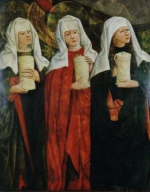Camargue Cross
The Camargue Cross is adorned with three tridents at the top, a heart in the centre and fish-tails at the base. This cross is the emblem of Saintes Maries de la Mer in the huge Camargue river delta, Provence-Alpes-Côte d'Azur, France.
Maries de la Mer means 'Marys of the Sea', which was named from medieval legends of the voyages of the three Marys: Mary of Cleopas, Mary Magdalene and Mary Salomé, mother of James and John (see Mark 16:1).
These three Marys were companions to Mary, the mother of Jesus, and found the empty tomb following Christ's resurrection. A few years later, around AD 40, they escaped persecution by fleeing Jerusalem by boat and reputedly arrived on the southern French shore. Bones were discovered in the 15th century and are believed to be their relics.
The Camargue cross is an emblem created by the artist Hermann Paul in 1924 at the request of the Marquis Folco de Baroncelli. This cross (shown on the left) was forged by Gédéon Blatière in 1930. It is near the Maure bridge not far from the Simbeu farmhouse, former home of the Marquis. Similar crosses are found in various parts of the town.
Overall, the symbol represents the three key Christian virtues mentioned in I Cor. 13:13
The town has been appreciated for its charm by Ernest Hemingway, Picasso, van Gogh and film location scouts. The local hero, however, is the Marquis. He had a passion for bulls and now each year in May, visitors can enjoy the bull-running festival.
The three-pronged forks at the top not only represent tridents, but also the tool used by manadiers (cowboys); bull-running being a fun tourist attraction. Not much fun for the bulls of course, and an increasing number of people are trying to banish the custom to the history books.
It is not for foreigners to dictate how other cultures behave but tourists who find the spectacle obnoxious can make their protest by boycotting such festivals, which will hasten the natural decline of such events. Meanwhile, the local supporters will enjoy the kill and not understand why others consider it unfortunate that such cruel entertainment was added as a 'cultural identity' on a Christian cross.
Yes, it is true that the cross was designed as an instrument of torture. But today, in Maries de la Mer and everywhere else in the world, the Cross is a symbol of love.


